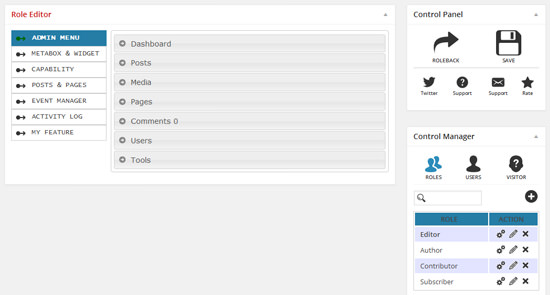10 WordPress Plugins To Improve User Management
Working with WordPress you probably are familiar with the different roles you can assign members of your team. The roles include administrator, author, contributor, subscriber and regular user, each with their own roles, capabilities and restrictions, for instance, contributors can only edit their posts, whereas editors can edit everyone’s posts.
If, however you want to be able to have improved control over user management, here are a few WordPress plugins that can help you alter, extend or change the capabilities for different roles in your website.
Recommended Reading: How to Find & Install WordPress Plugins Through Github
User Role Editor
User Role Editor adds functionality and flexibility for changing role capabilities for user roles. The plugin shows the list of capabilities of each role, and you can enable or disable the capabilities of specific roles. This plugin also allows you to create a new role with its own set capabilities.

New User Approve
By default, WordPress will accept every new user registration. If you want to prevent every registered user from gaining direct login into the site after they register, use this plugin.
With it enabled, when someone registers, the Administrator (most probably you) will receive a notification email, then you can decide whether to approve or reject the registration. Approved users will get an email with login credentials for granted access to the site.

Members
Members make WordPress more powerful in terms of user accesibility. Aside for enabling editing, creating, and deleting roles and capabilities, it also allows you to set permission to control which content is available for any specific user.

Multisite User Management
Multisite User Management is great plugin if you enable your WordPress site as Multisite (see our previous post in this matter: Beginner’s Guide to WordPress Multisite). This plugin enables you to add users with specific roles to each site in the network.

User Switching
User Switching allows you to quickly switch between user accounts on your site. Instantly log out from your current account and log into the another account simply by clicking the “Switch To” button, once the plugin is activated. It’s particularly handy for user testing during plugin or theme development.

Advanced Access Manager
Advanced Access Manager is powerful plugin that controls access to specific areas of your site like posts, pages, categories, widgets or menus for a specific user, role or visitor. This plugin also lets you manage roles and Capabilities so you can create, update or delete any user role or capability.
Other features include securing admin login by limiting login tries, controlling access to media files, tracking logged-in user activities, and the capability to filter backend menu and metaboxes or widgets.

Delete Me
Delete Me is a plugin which allows users to delete themselves. Upon activating the plugin, the “Delete Profile” link will appear on the user profile pages. By clicking this button and confirming the choice, users can get their account, posts, links and comments all deleted in one go.

PauPress
PauPress brings Customer Management System (CRM) functionalities to WordPress. This plugin allows you to build user profile and add as many custom fields as you need to provide more details about the users. With this plugin, you can keep track of each user on the site by monitoring their activities and logs.

User Meta Manager
User Meta Manager is a handy tool for modifying user metadata as well as adding custom meta. So, if you want to add new user input for example, telephone number or address, this is a good plugin to get that done.

WP-Members
WP-Members is a free membership management plugin that restricts content to registered users. While WordPress by default allows all content to be viewable by all, this plugin restricts all posts by default. You can however change the setting to restrict only some of the content.
The plugin comes with additional registration fields including name, address, phone, and email but if you need to, you can create your own custom registration fields.
